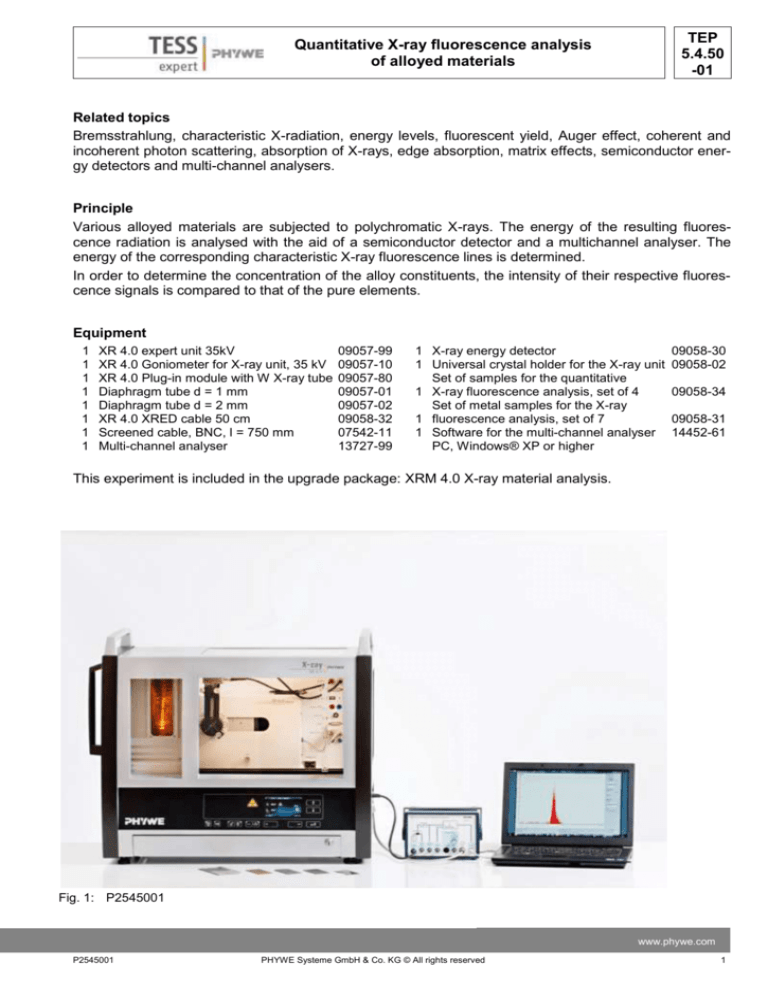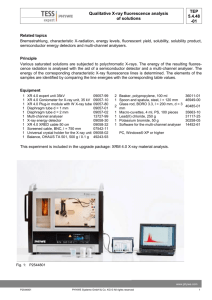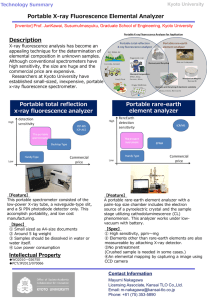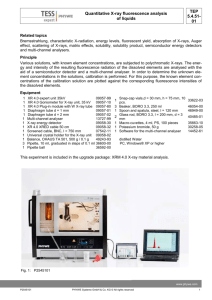
TEP
5.4.50
-01
Quantitative X-ray fluorescence analysis
of alloyed materials
Related topics
Bremsstrahlung, characteristic X-radiation, energy levels, fluorescent yield, Auger effect, coherent and
incoherent photon scattering, absorption of X-rays, edge absorption, matrix effects, semiconductor energy detectors and multi-channel analysers.
Principle
Various alloyed materials are subjected to polychromatic X-rays. The energy of the resulting fluorescence radiation is analysed with the aid of a semiconductor detector and a multichannel analyser. The
energy of the corresponding characteristic X-ray fluorescence lines is determined.
In order to determine the concentration of the alloy constituents, the intensity of their respective fluorescence signals is compared to that of the pure elements.
Equipment
1
1
1
1
1
1
1
1
XR 4.0 expert unit 35kV
XR 4.0 Goniometer for X-ray unit, 35 kV
XR 4.0 Plug-in module with W X-ray tube
Diaphragm tube d = 1 mm
Diaphragm tube d = 2 mm
XR 4.0 XRED cable 50 cm
Screened cable, BNC, l = 750 mm
Multi-channel analyser
09057-99
09057-10
09057-80
09057-01
09057-02
09058-32
07542-11
13727-99
1 X-ray energy detector
1 Universal crystal holder for the X-ray unit
Set of samples for the quantitative
1 X-ray fluorescence analysis, set of 4
Set of metal samples for the X-ray
1 fluorescence analysis, set of 7
1 Software for the multi-channel analyser
PC, Windows® XP or higher
09058-30
09058-02
09058-34
09058-31
14452-61
This experiment is included in the upgrade package: XRM 4.0 X-ray material analysis.
Fig. 1: P2545001
www.phywe.com
P2545001
PHYWE Systeme GmbH & Co. KG © All rights reserved
1
TEP
5.4.50
-01
Quantitative X-ray fluorescence analysis
of alloyed materials
Tasks
1. Calibrate the semiconductor energy detector
with the aid of the characteristic radiation of the
tungsten X-ray tube
2. Recording of the fluorescence spectra that are
produced by the alloyed samples.
3. Recording of the fluorescence spectra that are
produced by the pure metals.
4. Determination of the energy values of the corresponding fluorescence lines.
5. Calculation of the concentration levels of the alloy constituents.
Set-up and procedure
Set-up (Fig. 1)
Screw the adapter ring onto the inlet tube of the
Fig. 2: Connections in the experimentation area
energy detector.
Connect the signal and supply cables to the
corresponding ports of the detector with the aid
of the right-angle plugs.
Connect the signal and supply cables from the
MCA to the appropriate connections in the experiment chamber of the X-ray unit (signal cable: red, supply cable: green (see Fig. 2)).
Connect the external ports for the X RED of the
Fig. 3: Connection at the external panel of the XR 4.0 Xx-ray unit (signal cable red, supply cable green,
ray expert unit to the MCA
see Fig. 3) to the multi-channel analyse (MCA).
Connect the signal cable via a screened BNCcable to the “Input” port of the MCA and the
X-ray energy
supply cable to the “X-Ray Energy Det.” port of
detector
the MCA.
Secure the energy detector in the holder of the
swivel arm of the goniometer (Fig 4). Lay the
two cables with sufficient length so that the goniometer can be swivelled freely over the entire
swivelling range.
Connect the multi-channel analyser and computer with the aid of the USB cable.
Insert the tube with the 2-mm-aperture.
Left position of the
Bring the goniometer block and the detector to
goniometer
Universal crystal
their respective end positions on the left. Bring
holder with metal
the detector to the 90° position in the 2:1 cousample
pling mode (Fig. 4).
Calibration of the multi-channel analyser
(if there is no other already existing calibration that
can be used)
- Bring the goniometer block and the detector
Fig. 4: Set-up at the goniometer
2
PHYWE Systeme GmbH & Co. KG © All rights reserved
P2545001
Quantitative X-ray fluorescence analysis
of alloyed materials
-
-
-
-
-
TEP
5.4.50
-01
to their respective end positions on the
right.
Insert the tube with the 1-mm-aperture into
the exit tube of the X-ray tube.
With the X-ray unit switched on and the
door locked, bring the detector to the 0° position. Then, shift the detector by some
tenths degree out of the zero position in order to reduce the total rate.
Operating data of the tungsten X-ray tube:
Select an anode voltage UA = 25 kV and an
anode current IA = 0.02 mA and confirm Fig. 5: calibration of the multi-channel analyser
these values by pressing the “Enter” button.
Switch on the X-radiation
In the MEASURE program, select “Multi channel analyser” under “Gauge”. Then, select “Settings
and calibration”. After the “Calibrate” button has been clicked, a spectrum can be measured. The
counting rate should be < 300 c/s. Energy calibration settings: - 2-point calibration, - Unit = keV,
Gain = 2 – Set the offset so that low-energy noise signals will be suppressed (usually a few per
cent are sufficient), See Fig 5.
Measuring time: 5 minutes. Use the timer of the X-ray unit.
Make the two coloured calibration lines congruent with the line centres of the two characteristic
X-ray lines. The corresponding energy values (see e.g. P2544701) E(L3M5/L3M4) = 8,41 keV and
E(L2N4) = 9,69 keV are entered into the corresponding fields, depending on the colour. (Note:
Since a separation of the lines L3M5 and L3M4 Lines is not possible, the mean value of both lines
is entered as the energy of the line).
Name and save the calibration.
Spectrum recording
- Insert the tube with the 2mm-aperture.
- Bring the goniometer block and the detector to their respective end positions on the left. Bring the detector to the 90° position in the 2:1 coupling mode.
- Insert the sample with the universal crystal holder (sample at 45°).
- Operating data of the molybdenum X-ray tube: Adjust an anode voltage Ua = 35 kV and an anode
current so that the counting rate is ≤ 200 c/s.
- Measuring time: 10 minutes (use the timer of the X-ray unit).
Evaluation of the measurement curves
- In order to determine the line energy, switch from the bar display to the curve display. To do so,
click “Display options” and then “Interpolation and straight lines”.
- Extend the relevant line section with the aid of the zoom function
.
-
Then, select the curve section with
. Open the window “Function fitting”
“Scaled normal distribution” and confirm.
-
Find the line centroid of the normal distribution with “Peak analysis”
function “Survey”
(see Fig. 7).
. Then, select
or determine it with the
www.phywe.com
P2545001
PHYWE Systeme GmbH & Co. KG © All rights reserved
3
TEP
5.4.50
-01
Quantitative X-ray fluorescence analysis
of alloyed materials
Theory
In order to determine the concentration of the elements in a sample with the aid of X-ray fluorescence
analysis, a qualitative analysis must first be performed. During the assignment of the fluorescence lines,
it must be taken into consideration that the relaxations that follow the primary ionisation process can only
take place if they fulfil the quantum-mechanical selection rules Δj = 0, ±1 and Δl = ±1 (j = total angular
momentum, l = orbital angular momentum). In addition, it should be noted that every element has groups
of X-ray lines that have a certain intensity relation.
If, for example, one considers a specific line as the Kα-line of an element, it should be possible to detect
the corresponding Kβ-line in the correct intensity relation, provided that it is not overlaid by a line of another element. When the lines have been assigned to the elements, the line intensity allows for conclusions to be drawn about the concentration of the elements.
In general, matrix effects (see the appendix) make it difficult to determine the concentration directly.
This is why, in practical applications, quantitative analysis is performed via a comparison with the calibration functions that are stored in the computer and that have been created with certified reference samples.
If there are no matrix effects, the concentration ca of an element a of a sample can be determined based
on the relation between the intensity Ia of a line of the element and the intensity Ie of the same line of the
pure element, i.e.:
ca
Ia
Ie
(1)
As a first approximation, the intensity of a fluorescence line can be stated based on its peak value.
Evaluation
Evaluation of the constantan sample
Figure 6 shows the fluorescence spectrum of the constantan sample and the corresponding spectra of
the pure elements. Based on the Kα-lines, Figure 7 shows the method for evaluating these curves. The
corresponding values are shown in Table 1. The pulse numbers that are stated in the table have been
cleared up in terms of the background intensity (approx. 5 pulses).
Ni
Cu
Kα Ni
KαCu
Kα
Kα
Kβ
Kβ
Fig. 6: Fluorescence lines of constantan, copper, and nickel
4
PHYWE Systeme GmbH & Co. KG © All rights reserved
P2545001
TEP
5.4.50
-01
Quantitative X-ray fluorescence analysis
of alloyed materials
Kα Ni
KαCu
Kα Ni
KαCu
Fig. 7: Spectrum evaluation method: Kα-lines of constantan, copper, and nickel with a scaled normal distribution
Table 1: Constantan sample
Sample
Pure element
A
B
Linie
Cu
Ni
Kα
Kα
C
E /keV
D
Ie / Imp.
E
Ia / Imp.
F
ca / %
8,0
183
518
57,8
7,4
172
378
42,2
Column F in the table shown above includes the experimental concentration values of the constantan
sample. According to these values, the sample consists of 57.8% (≈ 55%) of copper and 42.2 (≈ 45%) of
nickel. (Data provided by the manufacturer of the resistance alloy constantan: Cu55Ni45)
Evaluation of a brass sample
Figure 8 shows the fluorescence spectra of a brass sample (CuZn39Pb3) and those of the corresponding pure elements. Again, only the α-lines are used for determining the concentration levels. The corresponding evaluation, with the background intensity being taken into consideration, can be found in Table
2.
Table 2: Brass sample (CuZn39Pb3)
Pure Element
A
Sample
B
Linie
Cu
Zn
Pb
Kα
Kα
Lα
C
E /keV
D
Ie / Imp.
E
Ia / Imp.
F
ca / %
8,0
974
546
56,0
8,6
1037
420
40,5
10,5
235
6
2,6
www.phywe.com
P2545001
PHYWE Systeme GmbH & Co. KG © All rights reserved
5
TEP
5.4.50
-01
Quantitative X-ray fluorescence analysis
of alloyed materials
Cu
Zn
Zn/Pb
Pb
Pb
Lα
Zn
Cu
Kα
Kβ
Lβ
Pb
Kα
Kβ
Fig. 8: Fluorescence lines of brass (CuZn39Pb3), copper, zinc, and lead
Appendix
Normally, the fluorescence intensity of an element A, with the same concentration in alloys with various
alloy constituents, is not identical. This shows that the fluorescence intensity of an element not only depends on the concentration, but also on the combination of elements that form the so-called matrix of the
element that is to be analysed.
If the energy of the fluorescence radiation of an element A is high enough to stimulate the fluorescence
radiation in element B, the radiation coming from B not only depends on the primary intensity, but also
on the concentration of element A. Vice versa, element A can absorb the radiation of element B. These
additional effects are known as matrix effects.
6
PHYWE Systeme GmbH & Co. KG © All rights reserved
P2545001







